"Cherishing Little Steps - A Haven for Baby and Family Journeys"
Fine Motor Skills Activities for Babies and Toddlers
When it comes to nurturing the budding skills of your little ones, think of their tiny hands as artists in the making. Engaging in activities that promote fine motor skills is important for their overall development.
From exploring sensory bins to creating masterpieces with playdough, each activity plays an essential role in enhancing their dexterity and coordination. The journey of discovery and growth begins with simple yet effective ways to hone these skills.
So, are you ready to unleash the potential within those small hands and witness the wonders they can create?
Key Takeaways
- Engage in finger painting and playdough activities to enhance fine motor skills.
- Explore sensory bins and water play for sensory development in babies and toddlers.
- Use educational games like puzzles for cognitive and motor skills development.
- Encourage creativity through activities like finger painting and music to enhance expression in young children.
Finger Painting Fun
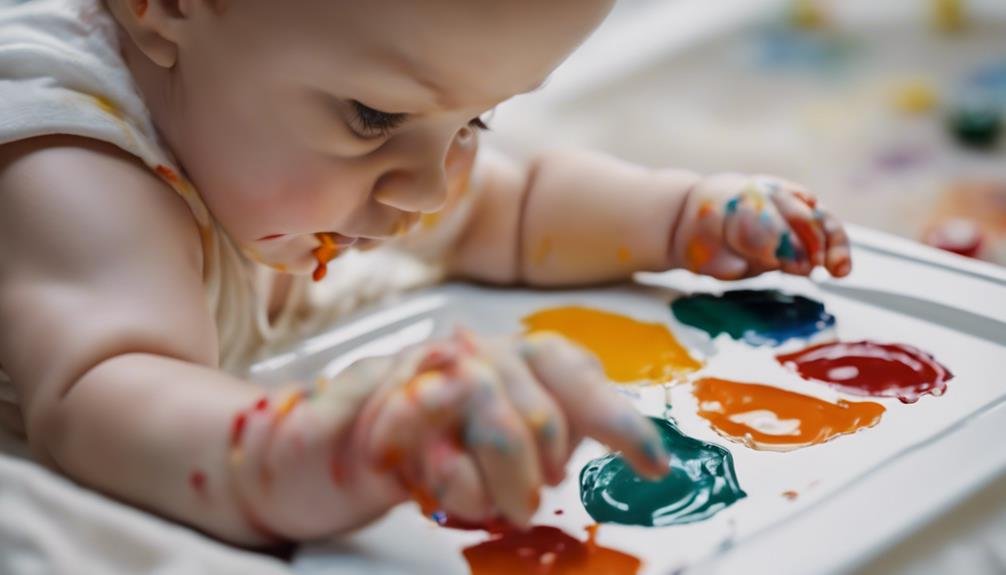
If you're looking for a creative way to engage your little one and enhance their fine motor skills, finger painting can be a fun and beneficial activity to try. Not only does it allow your child to explore their creative expressions, but it also helps in developing their hand-eye coordination and finger dexterity.
Finger painting is a fantastic activity that encourages your child to use their fingers to create colorful messes on paper, fostering their artistic abilities from a young age. The tactile experience of squishing paint between their fingers engages their senses and promotes sensory exploration. As your little artist smears, swirls, and mixes different colors, they aren't only having fun but also refining their fine motor skills.
To set the stage for a successful finger painting session, make sure you have washable, non-toxic paints and a protected surface for your child to work on. Encourage them to get messy and embrace their creative instincts. Remember, the joy is in the process, not just the final masterpiece!
Sensory Bin Exploration
Ready to take your child's sensory exploration to the next level? Sensory bins are a fantastic way to engage your little one's senses and assure their cognitive development. These tactile experiences can be both fun and educational, providing opportunities for learning through play. When setting up sensory bins, consider using a variety of materials such as rice, beans, water beads, or even themed items like shells or mini toys. This diversity can help stimulate different sensory receptors and keep your child engaged.
For mess-free sensory play, consider using a large tray or bin to assure the materials and make cleanup easier. Sensory bins offer numerous benefits, including improving fine motor skills, promoting creativity, and enhancing cognitive abilities. To enhance your child's sensory bin experience, try incorporating different textures, scents, or colors into the mix. Remember to supervise your child during sensory play to assure a safe and enjoyable experience for both of you. Enjoy watching your little one explore and learn through sensory bin play!
Playdough Creations
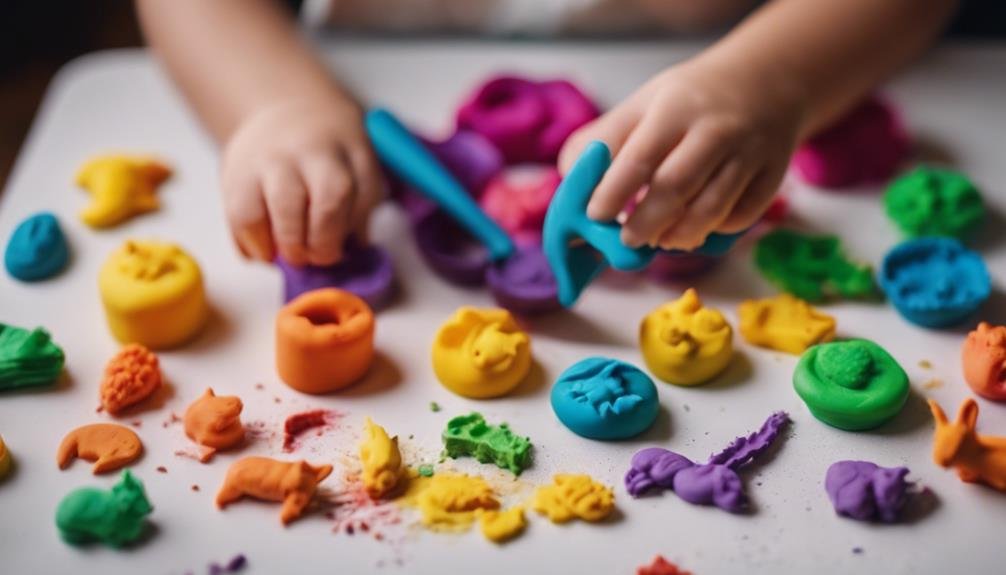
Engage your child's imagination and dexterity with fun and educational playdough creations. Playdough sculptures offer a fantastic way for your little one to immerse themselves into imaginative play while enhancing their fine motor skills. Encourage sensory play by incorporating different textures into their creations. Whether it's molding animals, shapes, or imaginary worlds, playdough opens the door to a world of creativity.
Through texture exploration, your child can experience the tactile sensations of squishing, rolling, and shaping the dough. This sensory engagement isn't only enjoyable but also aids in developing their sensory processing abilities. As they manipulate the playdough to form various objects, they're refining their hand-eye coordination and grip strength.
Provide them with tools like cookie cutters, rolling pins, or plastic knives to further enhance their playdough experience. Join in the fun, ask questions about their creations, and watch their confidence grow as they bring their imaginative ideas to life through playdough.
Sorting and Stacking Games
As your child explores playdough creations, they can further enhance their fine motor skills through engaging sorting and stacking games. These activities not only provide entertainment but also promote essential skills like color matching and shape recognition.
Here are three ways you can incorporate sorting and stacking games into your child's playtime:
- Color Matching with Blocks: Encourage your little one to stack blocks of the same color on top of each other. This simple game helps them practice identifying and matching colors while refining their hand-eye coordination.
- Shape Recognition with Sorting Toys: Provide toys with different shapes and ask your child to sort them into separate containers based on their shapes. This game aids in developing their ability to recognize and differentiate various shapes.
- Building Towers with Nesting Cups: Let your child stack nesting cups from largest to smallest or vice versa. This activity not only hones their fine motor skills but also teaches them about size relationships and sequencing.
Water Play Activities
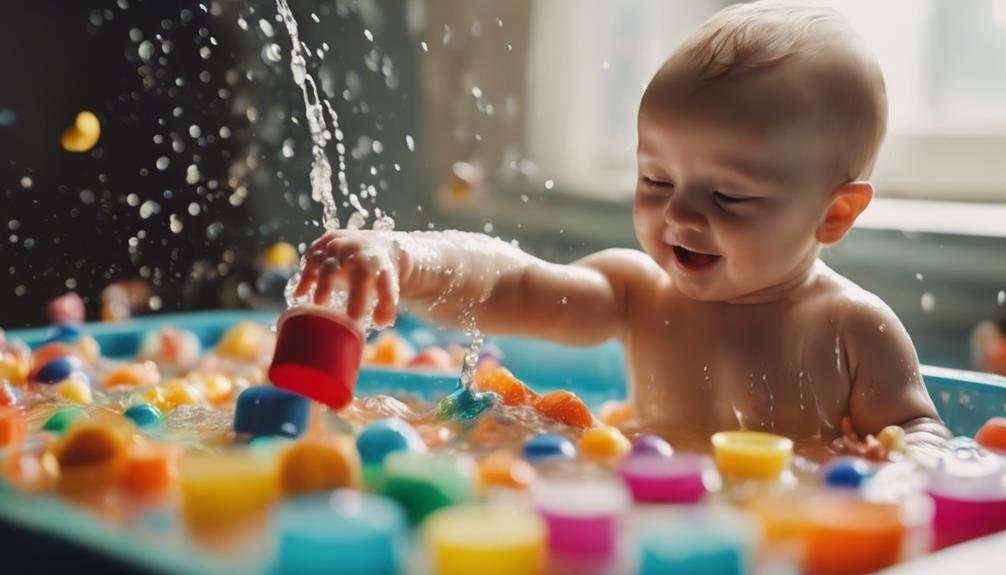
Immerse your child's sensory experience and fine motor skills with engaging water play activities. Bath time can be more than just a routine; it can be a time for learning and exploration. Encourage your little one's development by introducing splashing fun during bath time. Offer different sized cups and containers for pouring and filling, providing opportunities to enhance hand-eye coordination and grasp control.
For outdoor water play, consider having a water balloon fun session. This activity not only promotes hand strength but also improves visual tracking as your child follows the balloons flying through the air. Engaging in water balloon games can also enhance dexterity and hand flexibility.
Whether it's the calm environment of bath time or the excitement of outdoor water balloon fun, these activities offer a multi-sensory experience that can aid in your child's fine motor skills development. So, plunge into these water play activities to make learning a splashing good time!
Bead Threading Fun
Introduce your little one to the exciting world of bead threading, a fantastic activity to boost their fine motor skills and creativity. Colorful beads can capture your child's attention and imagination, making this activity both educational and entertaining. Here are some tips to make the most out of bead threading:
- Start with Larger Beads: Begin with bigger beads that are easier to handle. This will help your child develop their threading skills gradually and build confidence as they create their designs.
- Encourage Creative Designs: Allow your little one the freedom to experiment with different patterns and color combinations. This fosters creativity and enhances their artistic expression.
- Provide Guidance and Support: While independence is essential for skill development, offering guidance and assistance when needed can ensure a positive and rewarding experience. Celebrate their accomplishments and encourage them to keep exploring with the beads.
Engaging in bead threading not only refines your child's fine motor skills but also encourages them to think critically and creatively. Enjoy this enriching activity together and watch as your little one's imagination blooms through colorful bead creations.
Pincer Grasp Practice
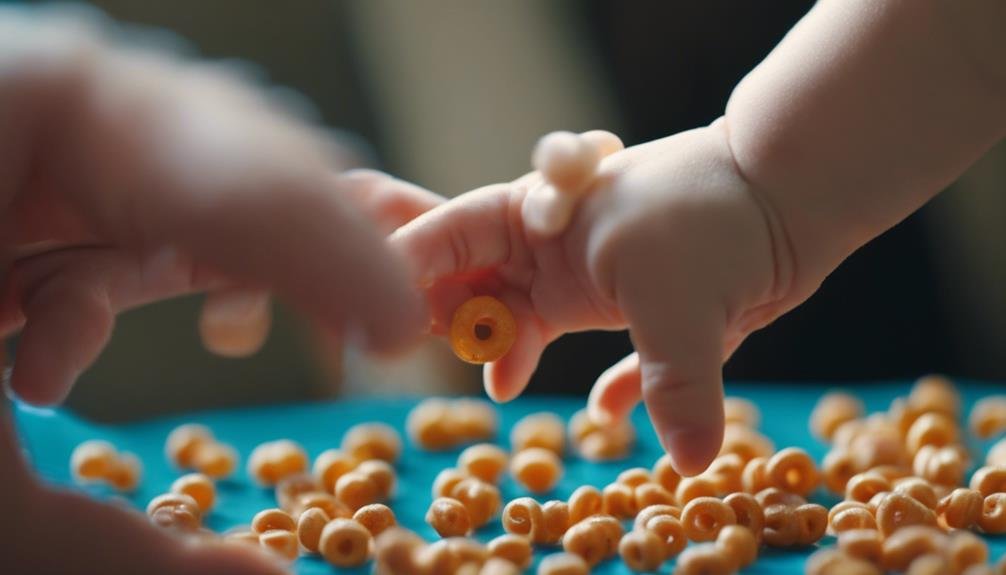
To help your little one develop their pincer grasp, try incorporating fun activities that involve picking up small objects using their thumb and index finger.
Encouraging food picking or object transferring during meal times can be a great way to practice this skill. You can offer small, bite-sized foods like peas or cheerios for them to pick up individually.
Another engaging activity is drawing dots on a piece of paper and having your child pick up small objects like buttons or beads to place on the dots. This not only enhances their pincer grasp but also helps with hand-eye coordination.
Remember to supervise closely during these activities to assure safety.
Scissor Skills Development
Developing scissor skills in young children can be a rewarding process that encourages fine motor coordination and creativity as they learn to manipulate scissors with precision and control. It's crucial to introduce cutting practice gradually to help your little one master this skill effectively.
Here are some tips to enhance your child's scissor control:
- Start with Play-Doh: Begin by letting your child practice cutting soft Play-Doh with safety scissors. This activity helps them understand the motion required for cutting.
- Use Lines and Shapes: Draw straight lines, curves, and simple shapes on paper for your child to cut along. This provides a guided task to improve their accuracy.
- Try Cutting Strips: Have your child cut strips of paper to enhance their hand strength and cutting skills. Progress to cutting out simple shapes as they gain confidence.
Puzzles and Shape Sorters
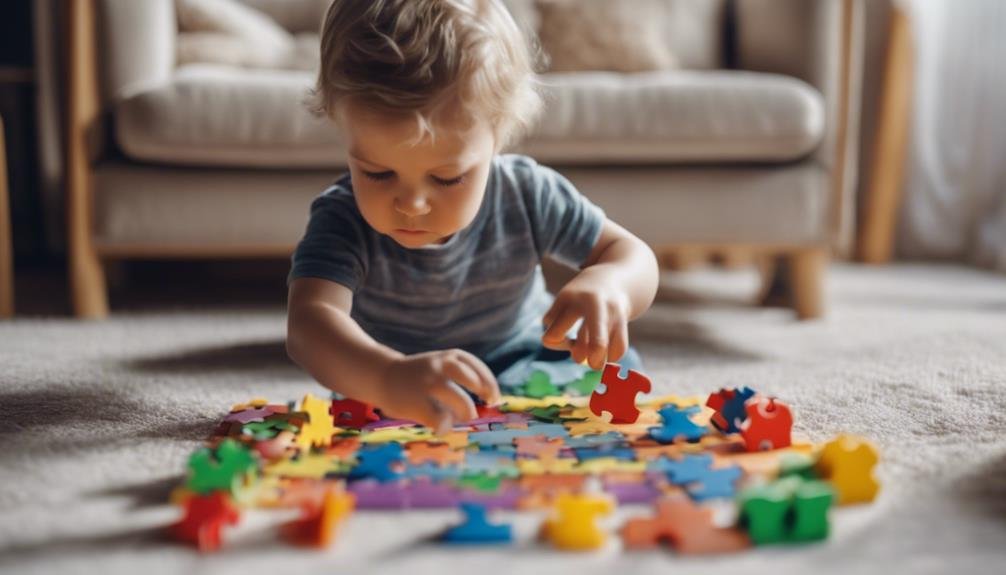
Engage your little one's cognitive and motor skills with interactive puzzles and shape sorters that provide both fun and learning opportunities. Puzzles and shape sorters offer problem-solving challenges that help develop your child's cognitive abilities and spatial awareness. As your baby or toddler manipulates the pieces to fit into the correct spots, they're actively engaging in critical thinking and honing their problem-solving skills.
Moreover, these activities contribute to cognitive development by encouraging pattern recognition. By identifying shapes and patterns, your child is laying the groundwork for more advanced cognitive processes. Shape sorters, in particular, enhance spatial awareness as your little one learns to match shapes and sizes to the corresponding holes.
Introducing puzzles and shape sorters at an early age can have lasting benefits on your child's fine motor skills and cognitive abilities. Make sure to choose age-appropriate puzzles and shape sorters to keep the activities engaging and enjoyable for your little learner.
Fine Motor Obstacle Course
Encourage your little one's fine motor skills through a fun and challenging Fine Motor Obstacle Course that will keep them engaged and motivated to develop their dexterity and coordination. Setting up an obstacle course at home can be a creative way to work on various motor skill development challenges with your child.
Here are three key elements to contemplate when creating a Fine Motor Obstacle Course:
- Fine Motor Challenges: Include activities like threading beads, stacking blocks, or placing small objects into containers to enhance your child's hand-eye coordination and finger dexterity.
- Obstacle Course Design: Incorporate tunnels to crawl through, cushions to balance on, and hoops to step in and out of to provide a mix of physical and fine motor challenges.
- Encouragement and Support: Cheer on your little one as they navigate through the course, offering praise and assistance when needed to boost their confidence and motivation to complete the challenges.
Designing a Fine Motor Obstacle Course at home can be an enjoyable way to engage your child in activities that promote their motor skill development while having fun together.
Music and Movement Activities

To enhance your child's sensory experience and foster physical coordination, consider incorporating fun music and movement activities into your daily routine. Engaging in dance parties and exploring musical instruments can be both entertaining and beneficial for your little one's development. Dance parties allow your child to move rhythmically to music, improving their coordination and balance. Playing with musical instruments not only enhances fine motor skills but also introduces them to different sounds and tones, stimulating their auditory senses.
| Activity | Description | Benefits |
|---|---|---|
| Dance Parties | Put on some lively music and dance together. | Enhances coordination and rhythm skills. |
| Musical Instruments | Introduce simple instruments like shakers or drums. | Develops fine motor skills and auditory senses. |
Incorporating these activities into your routine can provide a fun way for your child to explore their creativity while improving their motor skills. So why not turn up the music and have a dance party with your little one today?
Frequently Asked Questions
Are There Any Safety Tips to Keep in Mind While Engaging in Fine Motor Skills Activities With Babies and Toddlers?
When engaging in fine motor skills activities with babies and toddlers, safety precautions are key. Always provide close supervision, confirm age-appropriate challenges, and offer motivation. Your presence and guidance can help create a secure and stimulating environment for their development.
How Can Parents Encourage Reluctant Children to Participate in Fine Motor Skills Activities?
You can boost their interest by making it a fun challenge. Use games, colorful tools, and praise for motivation. Engage together, show excitement, and provide gentle guidance. Make it a special time for bonding and growth.
Are There Any Specific Materials or Toys That Are Recommended for Improving Fine Motor Skills in Babies and Toddlers?
For improving fine motor skills in babies and toddlers, consider using sensory play and Montessori toys. These tools can aid in reaching developmental milestones. Also, engaging in activities like finger painting can be beneficial.
How Long Should Babies and Toddlers Engage in Fine Motor Skills Activities Each Day?
You should engage babies and toddlers in fine motor skills activities for short periods throughout the day. Limit these sessions to 10-15 minutes to prevent frustration. This helps them develop essential skills while keeping the experience enjoyable. Tracking progress and celebrating milestones is key.
Are There Any Signs or Red Flags That Parents Should Look Out for to Indicate a Delay in Fine Motor Skills Development in Their Child?
When observing your child's fine motor skills, trust your instincts. Look for concerning signs such as persistent struggles with basic tasks or delays in hitting developmental milestones. Early intervention and parental observation can make a significant difference.
Conclusion
To sum up, engaging in fine motor skills activities with your little one is like planting seeds in a garden – you're nurturing their development and watching them bloom.
Keep exploring and trying out different activities to help them grow and thrive. Remember, it's not about perfection, but about the journey of learning and discovery together.
So keep on playing, creating, and having fun with your child as they continue to blossom like a beautiful flower.


